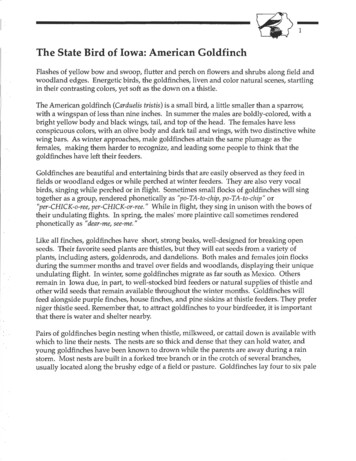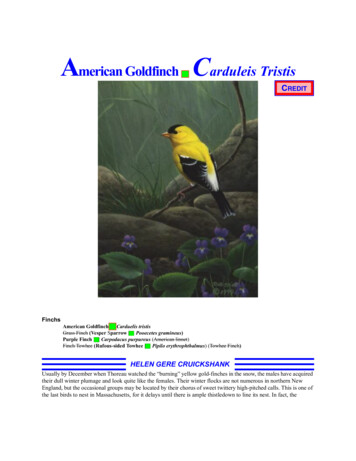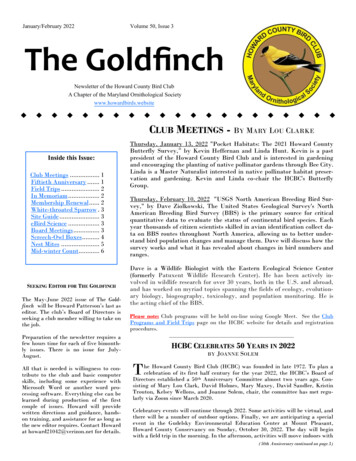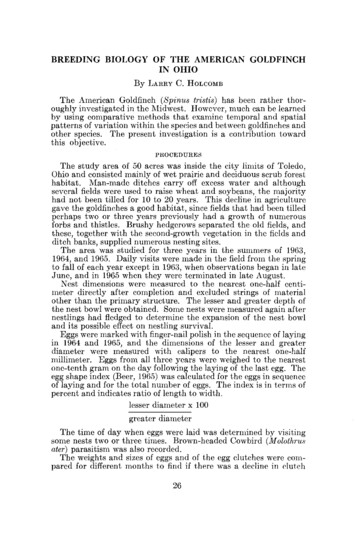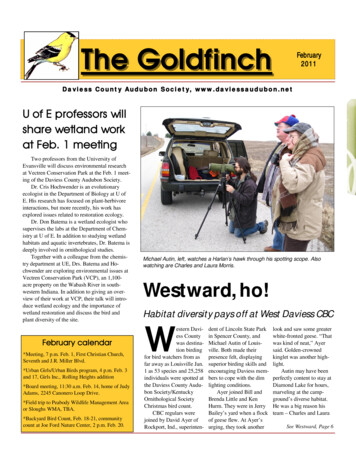
Transcription
The GoldfinchFebruary2011Da v iess Co unt y Audu bon Soci et y, www .dav iess aud ubo n.netU of E professors willshare wetland workat Feb. 1 meetingTwo professors from the University ofEvansville will discuss environmental researchat Vectren Conservation Park at the Feb. 1 meeting of the Daviess County Audubon Society.Dr. Cris Hochwender is an evolutionaryecologist in the Department of Biology at U ofE. His research has focused on plant-herbivoreinteractions, but more recently, his work hasexplored issues related to restoration ecology.Dr. Don Batema is a wetland ecologist whosupervises the labs at the Department of Chemistry at U of E. In addition to studying wetlandhabitats and aquatic invertebrates, Dr. Batema isdeeply involved in ornithological studies.Together with a colleague from the chemistry department at UE, Drs. Batema and Hochwender are exploring environmental issues atVectren Conservation Park (VCP), an 1,100acre property on the Wabash River in southwestern Indiana. In addition to giving an overview of their work at VCP, their talk will introduce wetland ecology and the importance ofwetland restoration and discuss the bird andplant diversity of the site.February calendar*Meeting, 7 p.m. Feb. 1, First Christian Church,Seventh and J.R. Miller Blvd.*Urban Girls/Urban Birds program, 4 p.m. Feb. 3and 17, Girls Inc., Rolling Heights addition*Board meeting, 11:30 a.m. Feb. 14, home of JudyAdams, 2245 Canonero Loop Drive.*Field trip to Peabody Wildlife Management Areaor Sloughs WMA, TBA.*Backyard Bird Count, Feb. 18-21, communitycount at Joe Ford Nature Center, 2 p.m. Feb. 20.Michael Autin, left, watches a Harlan’s hawk through his spotting scope. Alsowatching are Charles and Laura Morris.Westward, ho!Habitat diversity pays off at West Daviess CBCWestern Daviess Countywas destination birdingfor bird watchers from asfar away as Louisville Jan.1 as 53 species and 25,258individuals were spotted atthe Daviess County Audubon Society/KentuckyOrnithological SocietyChristmas bird count.CBC regulars werejoined by David Ayer ofRockport, Ind., superinten-dent of Lincoln State Parkin Spencer County, andMichael Autin of Louisville. Both made theirpresence felt, displayingsuperior birding skills andencouraging Daviess members to cope with the dimlighting conditions.Ayer joined Bill andBrenda Little and KenHurm. They were in JerryBailey’s yard when a flockof geese flew. At Ayer’surging, they took anotherlook and saw some greaterwhite-fronted geese. “Thatwas kind of neat,” Ayersaid. Golden-crownedkinglet was another highlight.Autin may have beenperfectly content to stay atDiamond Lake for hours,marveling at the campground’s diverse habitat.He was a big reason histeam – Charles and LauraSee Westward, Page 6
The GoldfinchPage 2Exploring artistry and restorationShea, Stratton discuss feasibility of native grasses plotThe time and cost of establishing a native grassesplot took center stage atthe Jan. 2 meeting of theDaviess County Audubon Society,Margaret Shea of Goshen’sDropseed Nursery and DavidStratton, the DCAS member whois spearheading a native grassesproject for the David C. Adkisson Greenbelt Park, shared theirthoughts about the project. Thechapter has received more than 500 in collaborative fundingfrom the National Audubon Society to start it.The Brescia University artprofessor said a site has yet to bechosen, and he is working withAnita Arends, Nature ResourcesConservation Service of theUSDA, to pursue matching“They’re spectacularly beautiful, really diverse. It’s not justthe grasses. It’s not just theplants. It’s all of the other animals that are a part of it.”Restoration doesn’t require are-creation of state prairies. It canbe accomplished on a smallerscale, for educational purposes.They also can be “functional”spaces to attract birds and butterflies, with the proper mix ofgrasses and flowering plants.The selection of the plantsMargaret Shea discusses native plants.funds. He is hoping to marry the nursery owner. Studies have esti- will be critical to the project’ssuccess and public acceptance. Itconcepts of ecological restoration mated that up to 2 million acresof prairie was once present in the depends greatly on how muchand landscape art to teach thestate. Now, the Nature Preserves sun an area gets and how moistpublic about Kentucky’s nativethe land is. She emphasized theCommission says, .5% remain.grasses.use of Kentucky species,Native grasses are a misnoThese grasses are a part ofmer, she noted, because of theKentucky’s history, noted MarSee Grasses, Page 5garet Shea, a Goshen native plant diversity of the plants.Brescia to feature landscape art exhibitWhat is landscape art all about?Come see for yourself at “Landscapes,”a new mixed-media sculpture exhibit byDoug DeWitt, an Illinois restoration ecologist for Tallgrass Restoration.In the winter 2011 edition of “Way ofthe Wilds,” author Kerry Leigh wrote thatDeWitt turned to landscape art, created withfound-object materials, “in an effort to relate his experience closer to the expressionof the landscape itself.”“Each piece becomes physically, ratherthan visually, literal because the materialsare those that make up his experience withthe landscape instead of simply his view ofit.”Just like his friend David Stratton’sproposal, the art is blended with restorationecology to help the land regain its health.“DeWitt sees the removal of invasivespecies as stretching the canvas and startingthe process. Existing and reintroduced native plants provide the textures and colorpalate,” Leigh wrote. “Light, wind, soil,fire, water, creatures and time all combineto create the composition, or work of art.”His show will remain in the Anna EatonStout Art Gallery from Jan. 29 – March 5.The gallery, on the second floor of the Campus Center, is open from 8 to 4:30 p.m.weekdays. An opening reception will beheld from 7 to 9 p.m. Jan. 29.“Shred” is one of the pieces in the DougDeWitt exhibit. (Photo courtesy of DavidStratton).
February 2011Page 3Girls Inc. program to focus on urban birdsDaviess County Audubon educators are launching an UrbanGirls/Urban Birds program this month, hoping to develop the nextgeneration of bird watchers.It’s an extensive program, one that will be conducted from 4 to5 p.m. on the first and third Thursday of the month from Februarythrough May at Girls Inc.’s Rolling Heights headquarters. Thirdand fourth-graders will work to learn about 15 urban birds throughsight and sound.While all visitors to the property will be celebrated, in its bid toget a Cornell University Celebrate Urban Birds mini-grant, the teamis required to work primarily with project birds designated by CU.That has been tweaked slightly, because some birds are simply notseen in the city of Owensboro. Birds that will be studied include:cedar waxwing, European starling, house finch, house sparrow,killdeer, mourning dove, peregrine falcon, rock pigeon, blue jay,northern cardinal, American crow, American robin, Baltimore oriole, barn swallow, brown-headed cowbird.“It’s going to be a learning experience for me,” said CourtneyCalhoun, Rolling Heights campus director. Director Tish CorreaOsborne is very excited about the possibilities, being an avid birdwatcher herself.DCAS president Brenda Little said the instruction would spreadacross many disciplines, with an emphasis on the arts. Workingwith pre-molded ceramic birds, nature journaling and music-basedsessions also are being considered.Education team members visited Girls Inc. to investigate howits habitat can be more bird-friendly. Newcomers were impressedby the possibilities. The main room has a covered back porch whichopens up into a garden area. They have a small amount of feeders,which will immediately be multiplied to encourage more birds tocome before the first session Feb. 3.It’s a continuation of work education chairwoman Winny Linhas done with Girls Inc. She planted some irises and daylilies on theFrom left: Brenda Little, Judy Adams, Tish Correa-Osborne,Winny Lin, Kenny Lin and Courtney Calhoun.property, as well as a butterfly bush and blackberry bush. Otherhabitat upgrades are forthcoming. Members were reluctant to immediately tackle the invasive honeysuckle along the property, notingthat it’s providing the birds with cover.That habitat is similar to that of neighborhood school Estes Elementary, the site of several school-based nature programs.The program will culminate around Mother’s Day with a celebration event featuring 10 minutes of bird watching from which thedata gathered will be submitted to Cornell’s Lab of Ornithology.Trip postponed; returns to Goose Pond, Peabody possibleSnow scuttled plans to travel Jan. 22 to the Sloughs Wildlife Management Area, but field trips will be discussed at the Feb. 1 meeting.DCAS members will be asked if they would prefer to reschedule the Sloughs trip or go to Peabody Wildlife Management Area Feb. 12.Both areas will feature waterfowl and other winter birds.Also being explored is a trip to the Greene County Marsh Madness Festival in Linton, Ind., March 5. The second annual event at GoosePond Fish and Wildlife Area celebrates the early spring migration of sandhill cranes. Goose Pond regular Charles Morris said he is hopefulthat a whooping crane could be spotted amid the sandhills.Along with bus and self-guided tours, there will be other educational programs – including one presented by the Hardy Lake Bird Rehabprogram – and other displays and arts and crafts in the Linton area, about 3 hours north of Owensboro.
Page 4The GoldfinchCount backyard bountyin Cornell’s national eventOn these endless drab winter days, is there anything betterthan a splash of color at the bird feeder? Or the oak tree in theyard?This year’s Great Backyard Bird Count is set for Feb. 18-21.Co-sponsored by the Cornell University School of Ornithology and the National Audubon Society, this mid-winter count provides important data forscientists. The vast area of the United States – and its millions of birds –makes it important forcitizens to watch theirbackyards and feeders tomonitor bird populations.Some of the questionsscientists wonder aboutinclude:-- How will this winter’s snow and cold temperatures influence birdpopulations?-- Where are winterfinches and other speciesthat appear in large num- A mourning dove feeds at Brushwood Apartbers during some yearsments.but not others?-- How will the timing of birds’ migrations compare with past years?-- How are diseases, such as West Nile virus, affecting birds in differentregions?-- What kinds of differences in bird diversity are apparent in cities versus suburban, rural and natural areas?-- Are any birds undergoing worrisome declines that point to the needfor conservation attention?The project is ideal for those reluctant to brave icy conditions and coldtemperatures that have bedeviled the region practically since Thanksgiving. Simply count birds for at least 15 minutes on one or more days of thecount. You can count each day or just some of the days and count in different places. Keep a separate list of birds for each day and each location. Foreach type of bird seen, count the most seen at any one time.2. Enter results on the Great Backyard Bird Count website,http://www.birdsource.org/gbbc/.Planning is under way for GBBC preparation with Girls Inc. as part ofthe Urban Girls/Urban Birds program and at Tamarack Elementary.In addition, the Joe Ford Nature Center, behind GRAAD on U.S. 60,will be hosting a Great Backyard Bird Count event from 2 to 4 p.m. Feb. 20.At the center, families will be counting birds around the Ford Centerproperty and adjacent part of the David C. Adkisson Greenbelt Park, including those which visit the suet, thistle and seed feeders at the center’s BirdSanctuary. It’s a great way to learn about winter birds and how we can helpthem when food supply is rapidly dwindling. Bring your binoculars and jointhe fun!Sandhills fly overhead. (Photo by Bill Fogle)Sandhills highlight day tripKen Hurm, Bill Fogle and Charles Morris found ajackpot of cranes during a day trip Jan. 15 to BarrenLake. Stopping for directions at Barren Lake lodge, thetrio were told to go down U.S. 31E about 3 to 5 milesand look in cornfields on both sides of the road.“On the right side of the road, we saw and guesstimate 350 to 500 sandhills,” Morris reported.Other birds on the trip included: American crow,white-breasted nuthatch, northern flicker, easternbluebird, downy woodpecker, European starling, darkeyed junco, house finch, northern cardinal, blue jay, redbellied woodpecker, red-tailed hawk, black vulture, turkey vulture, tufted titmouse, mallard, ring-billed gull,wild turkey, bufflehead, pileated woodpecker, great blueheron, Carolina wren, Canada goose and hairy woodpecker.Show of sympathy is appreciatedMike and Sherry Henshaw expressed thanks for support and those who contributed to a Moonlite Bar-B-QInn meal for the family after the death of Mike’s father:“Thank you much for the thoughts, prayers and forthe BBQ. You are a true group of friends.”Check received for light showThe Daviess County Audubon Society was presented a check for 720 at the Jan. 20 meeting of Daviess Fiscal Court for the chapter’s participation at Christmas for Panther Creek. Thanks to all who volunteered!
February 2011Page 5From the President’s PerchGender blend bringsidea mix to AudubonIBy Brenda Littleoften think about the things I like about theAudubon Society: our proud history, the funthat goes with on-going learning, friends whoshare the desire to make the world a betterplace all the while mixing recreation with education in face of the challenges involved with beingenvironmentalists, the chance to get to know thebest and brightest in environmental research andleadership, and the diversity of our members.It was when I read about another aspect of theAudubon Society in Bird Watcher’s Digest lastyear that I decided to write about yet “anotherthing,” another very good thing, in our Februarynewsletter. Did you know that in our club, fromcoast to coast and border to border, the two sexesare about equally represented? That makes us different from many organizations that tend to beheavily populated by one sex or the other.Having a balanced ratio between men andwomen makes for a good mix of ideas, approachesto problem solving, traits, talents and group harmony. I often think of how glad I am that I am halfof a couple in which both of us enjoy nature, theoutdoors, birding, the Audubon Society. But I thinkit is just as fortunate for our members who are single or whose spouses are not part of our flock thatwe are made up of both genders. It is just one morefacet of diversity that makes us an exciting organization.And so I chose February, the month when wecelebrate affection to think about the affection weshare as friends who love to share the fun and excitement that comes from an appreciation of naturewith a mixture of feminine and masculine viewpoints.And being as this will be my last February column as president of DCAS, I must pay tribute tomy husband’s favorite holiday, and to good olePunxsutawney Phil, who promises us that springwill surely come, maybe not as soon as we wish,but surely.David Stratton’s latest creation, sponsored by the family of J.D. Bailey, salutesbackyard birds on West Parrish Avenue.GrassesFrom Page 2emphasized the use of Kentucky species, with a mix of short and tall grassesand flowering plants.Possible grasses include “short”grasses (three feet tall) such as littlebluestem, side oats gramma and thefragrant prairie dropseed. Tall grasses(which can reach up to 8 feet tall) reviewed included: Indian grass, big bluestem. Flowering plants include: purpleconeflowers, butterfly milkweed, rattlesnake mast, bee balm, slender mountainmist, asters and ashy sunflowers.But introducing these colorful plantsrequires a lot of work – and time. Members would need to use pesticide to getrid of existing vegetation for an entiregrowing season before doing any planting, because these native plants are verypoor at competing for survival.Two options were presented. If thechapter were to seed the area, she recommended drill seeding, ¼ inch deep.The project would not be costprohibitive. She estimated it would costabout 250 for enough seed to plant fora quarter-acre.But, it does require patience. Shesums up the process like this: “The firstyear it sleeps, the second year it creepsand the third year it leaps.” It’s not untilthat third year when the flowering plantstake hold, making it attractive.More enthusiasm was shown forusing plant plugs, which would create afuller area by the second year. Chaptermembers are mindful of the need tomake it palatable to greenbelt neighbors.This will be labor-intensive, requiring watering, mowing on high settingand weed control, particularly before it’sestablished in its second year. Activemanagement is required to prevent thespread of invasive species – like honeysuckles and lespedeza – or woody species -- from overrunning it.This is the latest greenbelt art projectfor Stratton. He recently erected histhird “Birds of the Greenbelt” sculptureoff West Parrish Avenue, just off theparking lot of the shopping center anchored by Kmart.The backyard bird salute featuresblue jay, robin, Carolina wren, easternbluebird, indigo bunting, cardinal andAmerican goldfinch and Carolinachickadee.
Page 6The GoldfinchLove of watchingbirds agelessMuch of the DCAS mission revolves aroundeducating young people, but it’s also good to bereminded that learning is a lifelong process.The Goldfinch received a letter from ThelmaAnderson of an Ohio County assisted livingcenter, where J.D. Bailey, Brenda Little’s dadresides. She wanted to express gratitude for Billand Brenda Little and others who maintain thebird feeders at the center.“IFrom left: Rose Ann Radzelovage, Carolyn Williams, Henry Connor and JillFlachskam enjoy soup at Jan Howard’s home after a morning of counting birds.WestwardFrom Page 2Morris and Mary Kissel -- had more than40 species themselves, including redbreasted nuthatch. He was beyond thrilledto scope out a Harlan’s hawk, a westernsubspecies of a red-tailed hawk. But, others had their moments. Laura Morrisalerted the car to a large bird of prey,which turned out to be a bald eagle. MaryKissel was startled by a barred owl staringat her from the side of a bridge nearCurdsville.Horned larks are so elusive, they’realways a thrill. Jill Flackskam, HenryConnor and Carolyn Williams saw morethan 80, and Madeline Oetinger was delighted to see her first as she and Brendaand Tony Eaden visited Ben Hawes Parkand checked out feeders.Rose Ann Radzelovage tallied feederbirds at the Joe Ford Nature Center buthad better luck at Waymond Morris Park,where she saw seven horned larks. On thecircle’s other end, Fran and Lynn Tichenorsaw 20 Eurasian collared doves. Howardand Pat Augenstein also traveled the byways of the county, part of 180.5 milestraveled by the group.Species recorded included: Canadagoose, 203; greater white-fronted goose,21; gadwall, 12; mallard, 75; wild turkey,14; turkey vulture, 1; bald eagle, 1; northern harrier, 1; sharp-shinned hawk, 2;American kestrel, 48; red-tailed hawk, 20;Cooper’s hawk, 3; rock pigeon, 291; Eurasian collared dove, 91; mourning dove,216; barred owl, 1; belted kingfisher, 2:flicker, 19; red-bellied woodpecker, 35;downy woodpecker, 19; hairy woodpecker, 2; yellow-rumped warbler, 4; bluejay, 85; American crow, 35; commongrackle, 5,029; European starling, 3,393;red-winged blackbird, 10,160; rusty blackbird, 1; yellow bellied sapsucker, 1;golden-crowned kinglet, 5; horned lark,320; Carolina chickadee, 34; tufted titmouse, 11; white-breasted nuthatch, 5;red-breasted nuthatch, 2; Carolina wren, 9;cardinal, 111; eastern bluebird, 56; American robin, 49; northern mockingbird, 44:tree sparrow, 2; song sparrow, 36; housesparrow, 356; field sparrow, 12; whitethroated sparrow, 18; white-crowned sparrow, 2; Eastern towhee, 9; dark-eyedjunco, 39; eastern meadowlark, 4; brownheaded cowbird, 4,252; house finch, 63;American goldfinch, 33; swamp sparrow,4.wish to express my gratitude to thevolunteers from the Audubon Society who have tended to the bird feeders outside the assisted living whereI moved last May. I have never had a good window for bird watching until I moved here. I willbe 97 years old the 5th of February, and I haveenjoyed watching the beautiful birds outside mywindow immensely. It is my only contact withthe outdoors.“My granddaughter took me to Rural Kingthis fall, and I picked out the prettiest red barnstyle feeder which now hangs outside my window. I have turned my chair to an angle where Ican watch the birds all day. When my familycomes to visit, we all take delight in naming thebirds even when we have to wait for the blackbirds to leave so the smaller birds can get something to eat. Even my 5-year-old granddaughterknows the bird species.”“As I thank you for tending to my feederand the other feeders you fill for others, I wantalso to thank Kathy Bevil, the owner of theassisted living, for keeping a good supply ofbird seed on hand so ‘my birds’ visit the gardenoutside my window every day. Bless all of youfor the beauty and joy you bring into the livesof so many people.“P.S. But I do have a crick in my neck fromstraining to see the birds for hours every day.Collect plastic bottle capsHave plastic bottle caps lying around?They’re being collected at the Joe Ford Nature Center on behalf of Debbie Newman,West Louisville Elementary School teacher.With 250 pounds, the school can turn theminto a recycling center, which would usethem to create a bench for their new school.
Page 4 The Goldfinch Count backyard bounty in Cornell’s national event O n these endless drab winter days, is there anything better than a splash of color at the bird feeder? Or the oak tree in the yard? This year’s Great Backyard Bird Count is set for Feb. 18-21. Co-sponsored by




